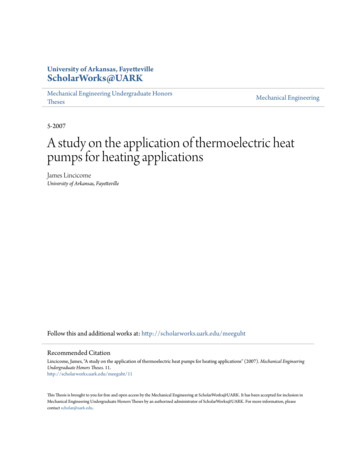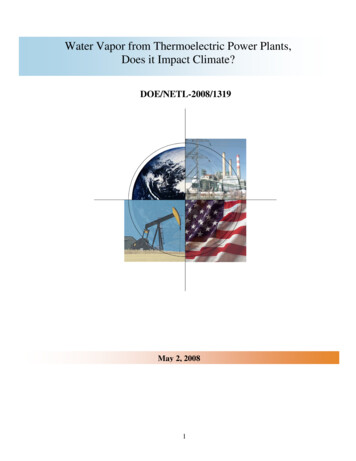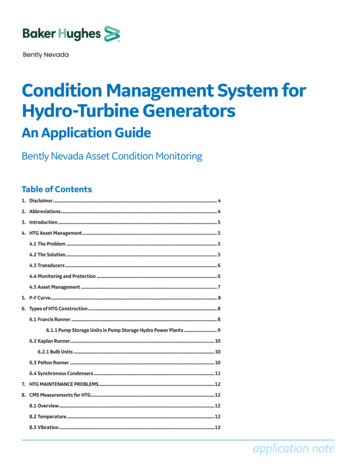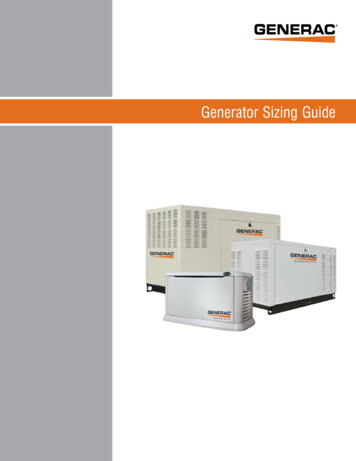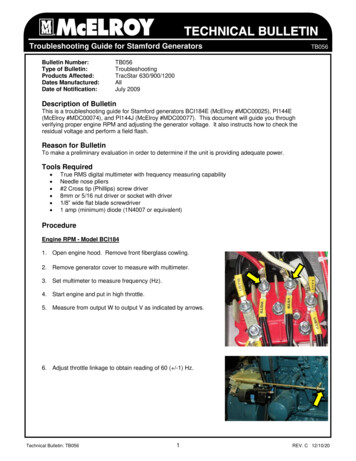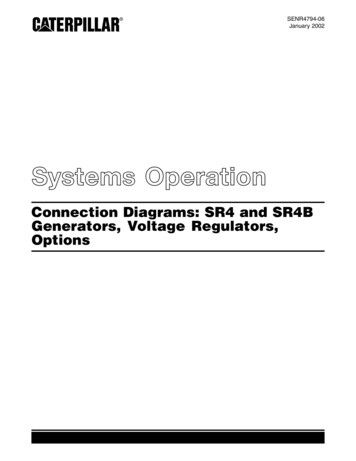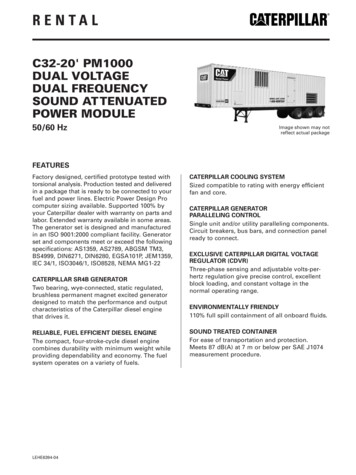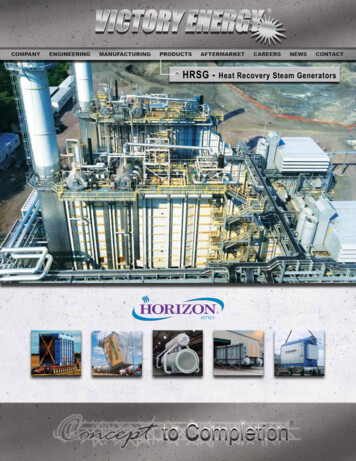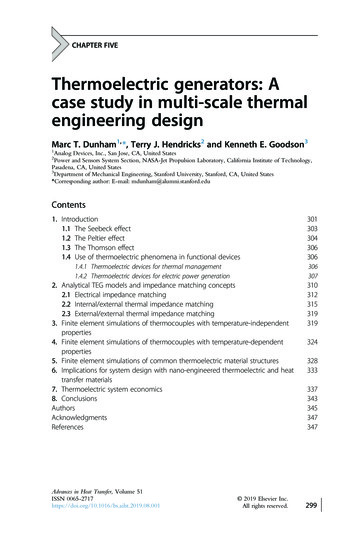
Transcription
CHAPTER FIVEThermoelectric generators: Acase study in multi-scale thermalengineering designMarc T. Dunham1, *, Terry J. Hendricks2 and Kenneth E. Goodson31Analog Devices, Inc., San Jose, CA, United StatesPower and Sensors System Section, NASA-Jet Propulsion Laboratory, California Institute of Technology,Pasadena, CA, United States3Department of Mechanical Engineering, Stanford University, Stanford, CA, United States*Corresponding author: E-mail: mdunham@alumni.stanford.edu2Contents1. Introduction1.1 The Seebeck effect1.2 The Peltier effect1.3 The Thomson effect1.4 Use of thermoelectric phenomena in functional devices1.4.1 Thermoelectric devices for thermal management1.4.2 Thermoelectric devices for electric power generation3063072. Analytical TEG models and impedance matching concepts2.1 Electrical impedance matching2.2 Internal/external thermal impedance matching2.3 External/external thermal impedance matching3. Finite element simulations of thermocouples with temperature-independentproperties4. Finite element simulations of thermocouples with temperature-dependentproperties5. Finite element simulations of common thermoelectric material structures6. Implications for system design with nano-engineered thermoelectric and heattransfer materials7. Thermoelectric system economics8. s in Heat Transfer, Volume 51ISSN 01301303304306306 2019 Elsevier Inc.All rights 9j
300Marc T. Dunham et al.AbstractIn this chapter we review the fundamental principles of thermoelectric phenomena,devices, and optimization techniques, with a focus on the multi-scale design of thermoelectric energy generators (TEGs). TEG technology represents a fascinating case study ofthe interplay between thermal and electrical transport, with pronounced multi-scaleimpacts from nanoscale phonon and electron transport to the design of efficientheat exchangers in the optimization of a complete system. We explore several of theseareas in detail, with particular attention given to the effects of temperature-dependentthermoelectric material properties on the optimal ratio of hot-to-cold side heatexchanger thermal resistances and the relation to the second law of thermodynamicsin the macroscale system design. These conclusions are then connected to theorybehind the design of thermoelectric materials through nanoengineering. Finally, weexplore cost considerations related to TEG system heat exchanger design, offering anew perspective in the approach to the technoeconomic optimization of TEG C000CpFFoptGIKexhKHKCKHXKTElmm hnTCPq00QReRt,extRt,ext,hRth,ext,cSTUAuTE/heat exchanger interface area [m2]Thermoelectric element area [m2]Thermoelectric generator cost [ ]Heat exchanger cost parameter [ (W K 1) 1]TE system manufacturing/fabrication costs per area [ m 2]TE material volumetric costs per volume [ m 3]Exhaust flow specific heat [J kg 1 K 1]Fill factor [ ]Optimum cost fill factor [ ]Thermoelectric system cost per watt [ W 1]Current [A]Heat exchanger conductance [W K 1]Hot side total thermal conductance [W K 1]Cold side total thermal conductance [W K 1]Heat exchanger conductance value [W K 1]Effective thermoelectric conductance [W K 1]Thermoelectric element length [m]Load resistance ratio [ ]Exhaust mass flow rate [kg sec 1]Number of thermocouples [ ]Power [W]Heat flux [W m 2]Heat transfer rate [W]Electrical resistance [U]Total external thermal resistance [K W 1]Hot side thermal resistance [K W 1]Cold side thermal resistance [K W 1]Seebeck coefficient [V K 1]Temperature [K]Heat exchanger UA value [W K 1]
Thermoelectric generators: A case study in multi-scale thermal engineering designVXZZT301Voltage [V]Lost exergy [W]Thermoelectric material figure of merit [K 1]Dimensionless thermoelectric figure of merit ¼ Z *TGreekDTεgkhcTemperature Differential [K]Heat Exchanger Thermal EffectivenessThermoelectric Element Length to Area Ratio [m 1]Thermal Conductivity (thermoelectric material unless otherwise specified)[W m 1 K 1]Thermoelectric Conversion EfficiencyHeat Loss Factor Quantifying Heat Losses (¼Qloss Qh,TE 1)SubscriptsambexhhcnpTEHEXambient environmentexhaust conditionsassociated with hot-side parameterassociated with cold-side parameterassociated with TE n-type materialsassociated with TE p-type materialsThermoelectric parameterHeat Exchanger parameter1. IntroductionThermoelectric phenomena in materials result in the coupling of electric charge and thermal energy transport primarily through the Seebeck,Peltier, and Thomson effects. When properly assembled into a device architecture, materials exhibiting these effects enable the direct conversion ofthermal energy to electricity in one configuration, or a heat pump developing a thermal gradient in response to an input of electric power. Thermoelectric effects are present to some degree in all materials with free electronsor holes, though they are most prominent and useful in a small subset ofmetals and semiconductors which present a favorable combination of thermal and electrical transport properties through the thermal and electricalconductivity parameters, as well as the thermally-driven electrical chargecarrier diffusion captured by the Seebeck coefficient.Metals with sufficient Seebeck coefficient are widely used for temperature measurement in thermocouples, as the temperature difference along thelength of the metal wire is proportional to a developed electrical potentialmeasured as a voltage. Various combinations of materials have become standardized as specific thermocouple types, for example the K-type thermocouples comprised of wires of nickel-chromium and nickel-alumel which
302Marc T. Dunham et al.are welded together at one end to form a junction at which to probetemperature.Semiconductors are more common in complex functional devices forthermal management and power generation applications, and most successful applications of thermoelectric devices rely on relatively complex materials. The most common set of basis materials for thermoelectricapplications near room temperature utilizes thermocouples of bismuth telluride (Bi2Te3) and antimony telluride (Sb2Te3) compounds. Thermoelectricmaterial properties are generally highly temperature-dependent, and athigher temperatures (i.e. several hundred degrees Celsius) the preferencefor Bi2Te3/Sb2Te3 systems yields to other materials including lead telluride(PbTe) and silicon germanium (SiGe), appropriately doped to achieve desirable properties. Functionalized thermoelectric devices present many additional complications which are irrelevant in metal thermocoupletemperature-sensing applications. For example, in a power generating orheat pumping thermoelectric device, many alternating thermoelementsmust be assembled into a thermopile, or series of thermocouples, in orderto benefit from series-additive electric potentials. This presents challengesin material interconnects to transport electric charge throughout the device,which introduces metal/semiconductor interfaces and (sometimes) significant electrical contact resistances. The assembly must be packaged into a mechanically-robust device, and must be coupled to the surroundingenvironment to absorb and dissipate heat on either side of the device.This component in particular introduces important system-level optimization considerations, as the performance of the device will be largely dictatedby the quality of thermal coupling to the heat source and sink. Furthermore,the addition of heat exchangers to the design alters the formulation throughadditional resistance and cost considerations which may easily shift the parameters for the ideal engineering design away from the ideal theoretical design.In this chapter, we endeavor to present a more comprehensive perspective on the analysis and design of thermoelectric power generation systems,as opposed to literature which most often focuses on a particular aspect of thesystem such as material properties or generator geometry without consideration for other high-impact components in the thermal pathway. Furthermore, there is little or no prior experimental work in optimizing TEGoutputs relative to adjusting external thermal resistances on a TEG systembecause this is quite expensive and no one has really had the budget or motivation to address this experimentally. Therefore, this work and much priorwork has focused on analytic models to bound the optimization problem forspecific designs, analyze specific cases, or otherwise apply design-specific
Thermoelectric generators: A case study in multi-scale thermal engineering design303boundary conditions appropriate to a given application or project. TEG systems have been investigated and applied to some automotive applications inU.S. Department of Energy projects, where optimized systems wereattempted, but significantly underachieved, due thermal interface issuesand hot-side and cold-side thermal resistances that were not properly optimized or design conditions were not solidly specified due to unknown transients [1-4]. TEG systems have been proposed in industrial waste heatrecovery [5], but never implemented because cost and performance optimized systems have not been attainable to date, in part because designersand design work did not focus properly on hot- and cold-side thermal resistance optimization as discussed extensively herein. A comprehensive performance analysis completely encompassing the combined effects of hot- andcold-side thermal resistances, such as performed and described herein, isrequired to begin to address the requirements on hot- and cold-side thermaldesign to optimize TEG systems. This treatment illustrates thermoelectricpower generation systems as highly-coupled, inter-disciplinary deviceswhich will be best applied in real-world engineering applications whenthe multi-scale contributions of the system from nanoscale energy carriertransport all the way to ambient heat exchangers are considered. To laythe groundwork for the analyses in this chapter, we begin with an overviewof the primary thermoelectric phenomena and their significance in developing a functional thermoelectric device.1.1 The Seebeck effectIn the presence of a temperature gradient, carriers such as phonons (matterwaves which carry thermal energy through the lattice), free electrons, orfree holes will transport thermal energy from the hot end of a material tothe cold end through diffusion mechanisms. When diffusion of free electronsand holes occurs, an electric potential will also be established across the materialas the population density of charge carriers increases at the cold end, which issustained by the thermal energy diffusion. Depending on the majority electriccharge carrier of the material (electrons in n-type semiconductors and holes inp-type semiconductors), either a positive or negative voltage potential will bepresent along the thermal gradient as illustrated in Fig. 1, which is representative of parallel thermoelements in electrical isolation from each other.The Seebeck voltage is the electromotive force reacting to the buildup ofcharged carriers in the material and is defined mathematically as the productof the temperature gradient VT and the Seebeck coefficient S:Eemf ¼ SVT(1)
304Marc T. Dunham et al.Fig. 1 Illustration of the Seebeck effect in n- and p-type thermoelectric materials.This term contributes to the electric current density J, such that: J ¼ s VV þ Eemf(2)In the absence of electric current flow through the material (i.e. opencircuit), the Seebeck coefficient can be defined, and measured, as thenegative ratio of the local voltage and temperature gradients:S¼ VVVT(3)Eq. (3) is valid for zero current flow through the material and for smalltemperature gradients, as the Seebeck coefficient is in general a temperature-dependent property. In semiconductors exhibiting strong thermoelectricproperties, the Seebeck coefficient of a p-type material will have positive polarity, while the Seebeck coefficient of an n-type material will have a negativepolarity. In the nominal Bi2Te3/Sb2Te3 thermoelectric system, Bi2Te3 is ann-type material and typically exhibits a Seebeck coefficient value nearroom temperature of -200 to -220 mV K 1, while Sb2Te3 is a p-type materialwith a typical room temperature Seebeck coefficient near þ170 mV K 1.1.2 The Peltier effectWhen electric current is passed through a thermoelectric material, heat, inaddition to electric charge, is transported by the diffusion of the charge carriers. If two dissimilar materials, such as those illustrated in Fig. 1, are broughtinto electrical contact, a junction forms at the interface. When the electriccurrent passes through this junction, a discontinuity in heat flow drivenby the electric current arises due to the change in local Seebeck coefficient,and heat is either absorbed or rejected at the interface as a result of the
Thermoelectric generators: A case study in multi-scale thermal engineering design305requirement for energy conservation. This phenomenon is referred to as thePeltier effect, and with conventional current flowing from material 1 to material 2, is described mathematically as:Q Peltier ¼ ðS1 T1 S2 T2 ÞI1/2(4)where T1 and S1 are the local temperature and Seebeck coefficient of material 1 at the interface, T2 and T2 are the local temperature and Seebeckcoefficient of material 2 at the interface, and I1/2 is the current passingthrough the junction from material 1 to material 2. In a thermoelectricdevice, this phenomenon typically occurs at the interface of one of thethermoelements and an interconnect material used to electrically connectthe p-type and n-type materials. The interconnect materials are typicallymade of a conductive metal such as copper or gold, which exhibits a largeelectrical conductivity and a low Seebeck coefficient. The effect is illustratedin Fig. 2 for a single thermocouple of an n-type material (Sn 0), a p-typematerial (Sp 0), and a metallic interconnect (S w 0).With the direction of electric current flowing from n-type to p-type material after the standard convention of following the positive charge carriers,the heat rate described in Eq. (4) is negative at the top of Fig. 2 (Q ¼ðSn 0ÞTI þ and Q ¼ ð0 Sp ÞTI þ ), indicating that heat is absorbed atthe junctions as illustrated in the figure. In a device designed as a heatpump, this end would be placed in thermal contact with a heat sourcerequiring thermal energy removal, such as a high heat-flux electroniccomponent or the interior of a refrigerated cavity. Conversely, the heatrate is positive at the interfaces at the bottom of Fig. 2 (Q ¼ ð0 Sn ÞTI þand Q ¼ ðSp 0ÞTI þ ), indicating that heat is rejected or released at thejunctions. In the heat pump system, this end would be connected to aheat sink which would dissipate thermal energy to ambient, typicallythrough natural or forced convection. In this manner, the thermocoupleFig. 2 Illustration of the Peltier effect in a thermocouple structure.
306Marc T. Dunham et al.acts as a heat pump from top to bottom in the figure. Changing the directionof electric current likewise reverses the direction of heat pumping, whichalso permits the use of these devices in systems requiring active thermal control with a feedback design, as it is able to supply heat to or remove heat fromone side with just a flip in polarity of the connected current source.1.3 The Thomson effectWhen a temperature gradient is present which results in variation of thetemperature-dependent Seebeck coefficient, electric current passingthrough the material will cause the release or absorption of a continuous differential amount of heat along the current pathway inside the material topreserve energy conservation. This heat arises from the Thomson effect,which in essence is the Peltier effect inside a single material due to differential changes in the local Seebeck coefficient, taking the form:dSQ Thomson ¼ ITdT(5)In the Thomson heat relation, the change in Seebeck coefficient across alocal thermal gradient acts as the “dissimilar junction” which gives rise to thePeltier effect described in Eq. (4).1.4 Use of thermoelectric phenomena in functional devicesThe thermoelectric phenomena described in Sections 1.1-1.3, most significantly the Seebeck and Peltier effects, lend themselves to convenient usefor solid-state thermal management and electric power generation. Suchdevices offer distinct benefits to traditional working fluid-driven thermodynamic systems, in their ability to provide a compact solution with no movingparts. Here we outline the basic structure and functionality in assembledthermoelectric device architectures.1.4.1 Thermoelectric devices for thermal managementThermoelectric devices enjoy relatively widespread use as thermal management solutions for systems requiring active heating and cooling, with applications including refrigerators [6], vehicle seat temperature controllers [7],coolers for microelectronics [8], and more. While typically demonstrating alower coefficient of performance than traditional thermodynamic heat pumpsand refrigeration cycles, advantages exist in their rapid response time and thefact that they are solid state devices with no moving parts [6]. Thermoelectricdevices used in this manner rely fundamentally on the Peltier effect, describedin Section 1.2. By arranging a large number of thermocouples thermally inparallel and electrically in series as illustrated in Fig. 3, a driving current will
Thermoelectric generators: A case study in multi-scale thermal engineering design307Fig. 3 Illustration of vertically-aligned Peltier device with thermoelectric elements arranged thermally in parallel and electrically in series. In this design, current would besupplied using the protruding square contact pads and heat would be pumped upor down through the device, depending on the direction of electric current.pump heat from one side of the device to the other via heat absorption orrejection at each material junction according to Eq. (4).The magnitude of heat released or absorbed at each junction is proportional to the transmitted electric current, and to a point an increase in electriccurrent drives more heat through the device by the Peltier effect. However,the materials in a Peltier device are not perfect conductors, and resistiveJoule heating enters the heat balance proportional to the square of current as:Q Joule ¼ I 2 R(6)This competing term dominates with sufficiently high currents in a Peltier device, resulting in an optimal cooling condition, after which point Jouleheating will dominate and release heat throughout the entire device.1.4.2 Thermoelectric devices for electric power generationThough Peltier devices for thermal management have comprised the bulk ofthe thermoelectrics market for many years, devices for power generation arereceiving increased interest in a variety of applications beyond legacy spacecraft power generation in recent years. The remainder of this chapter willfocus on the configuration used to convert thermal energy to electricity,known as a thermoelectric generator (TEG), and various factors illustratingthe complexity of optimizing the power transfer in a highly-interconnectedengineering system. For electric power generation, thermoelectric devicesmake use of the Seebeck effect described in Section 1.1. Like thermal management devices such as Peltier coolers/heaters, thermoelectric generators
308Marc T. Dunham et al.are most commonly designed with thermoelements which are arrangedthermally in parallel and electrically in series, as in Fig. 3. By connecting alarge number of thermocouples in this manner, the electric potential produced by the Seebeck effect is linearly related to the thermocouple countnTC as given in Eq. (7):VSeebeck ¼ nTC Snet DTTE(7)When the circuit is closed with an electric load, power is tr
CHAPTER FIVE Thermoelectric generators: A case study in multi-scale thermal engineering design Marc T. Dunham1,*, Terry J. Hendricks2 and Kenneth E. Goodson3 1Analog Devices, Inc., San Jose, CA, United States 2Power and Sensors System Section, NASA-Jet Propulsion Laboratory, California Institute of Technology, Pasadena, CA, United States 3Department
